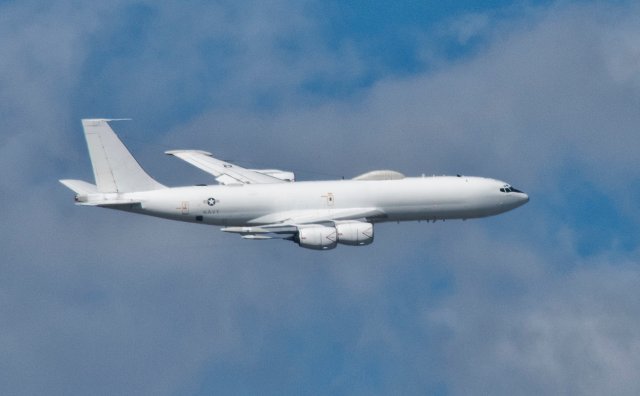| a | |||
|
|
|||
|
World Defense & Security News - United States
|
|||
|
|
|||
|
USAF upgrading Minuteman III ICBM airborne launch control system
|
|||
|
The US Air Force awarded two contracts Oct. 3, 2017, for upgrading the system that enables an aircraft to control an intercontinental ballistic missile’s launch from a silo in the ground. The three-year contracts, of about $81 million each, were awarded to Lockheed Martin Space Systems, Littleton, Colorado, and Rockwell Collins, Cedar Rapids, Iowa, the Air Force Global Strike Command Public Affairs said on Oct. 5, 2017.
|
|||
|
|
|||
 A U.S. Navy E-6B Mercury airborne command post flies over Solomons Island, Md. The aircraft provides airborne command, control, and communications. The E-6B is a dual-mission aircraft capable of fulfilling either the E-6A mission or the airborne strategic command post mission and is equipped with an airborne launch control system capable of launching U.S. land based intercontinental ballistic missiles A U.S. Navy E-6B Mercury airborne command post flies over Solomons Island, Md. The aircraft provides airborne command, control, and communications. The E-6B is a dual-mission aircraft capable of fulfilling either the E-6A mission or the airborne strategic command post mission and is equipped with an airborne launch control system capable of launching U.S. land based intercontinental ballistic missiles(Credit: U.S. Navy) |
|||
|
|
|||
|
The awards begin a design competition for upgrading the nuclear command-and-control mission system that provides U.S. Strategic Command with the capability to launch ICBMs through commands from the Navy’s E-6B Mercury. Both the current Minuteman III and future Ground Based Strategic Deterrent ICBMs require an alternate launch control capability should anything interfere with the ability of the ground-based facilities to launch ICBMs.
For the Minuteman III, the current Airborne Launch Control System provides this capability through 1960s-era radio equipment at each of 450 Air Force ICBM launch facilities in the U.S. and aging equipment on the Mercury aircraft. The control system’s replacement will provide a sustainable and low-cost capability to launch ICBMs through aircraft commands. “We are developing a modular system that can be easily upgraded to address new technologies and threats as they emerge,” said Maj. Gen. Scott Jansson, Air Force Nuclear Weapons Center commander and program executive officer for strategic systems. The goal of the center’s program office at Hill Air Force Base is to field the upgraded replacement system by 2024. “The Airborne Launch Control System provides the strategic capability of survivable airborne command and control for the Air Force’s fleet of ICBMs,” said Col. Scott Jones, the center’s ICBM Systems director. “The new system will be a timely replacement of the legacy system and provide continued ICBM airborne command-and-control capability through 2075.” The Air Force Nuclear Weapons Center is responsible for synchronizing all aspects of nuclear materiel management on behalf of Air Force Materiel Command in direct support of Air Force Global Strike Command. Headquartered at Kirtland AFB, New Mexico, the center has about 1,100 personnel assigned to 17 locations worldwide, including at Hanscom AFB, Massachusetts; Hill AFB; Eglin AFB, Florida; Tinker AFB, Oklahoma; and Ramstein Air Base, Germany. |
|||
















